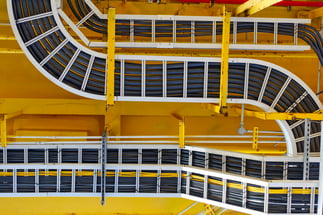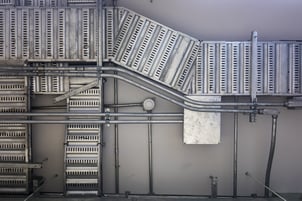 Most of us have a startling amount of tangled cables and connectors on, below, and behind our desks. Multiply that by a hundred or even a thousand, and you have a better idea of the cables and wiring that need to be managed for machinery in an entire manufacturing facility.
Most of us have a startling amount of tangled cables and connectors on, below, and behind our desks. Multiply that by a hundred or even a thousand, and you have a better idea of the cables and wiring that need to be managed for machinery in an entire manufacturing facility.
Wire and cable can be found all over a manufacturing facility. They are the life source of all power equipment and are required to fit in tight spaces, reach long distances, and still manage to not get in the way of day to day operations on the floor. The answer to all this cable chaos? Cable trays.
Cable trays are a mechanical support system that can support electrical cables used for power distribution, control, and communication. They are the perfect solution for running large quantities of power or data cables overhead or under-floor. Cable trays come in all shapes and sizes and due to some regulations, require different accessories like sides or covers. They can be made of steel, aluminum, or fiber reinforced plastic. Understanding what cables you will install and how far they run are important when exploring the different type of cable trays for your machine or customer facility.
Types of cable trays
Ladder
Ladder cable trays are used for about 75 percent of the cable tray wiring system installations. It is the predominate cable tray type due to its many desirable features. Without covers, it allows maximum free flow of air across the cables. This allows the heat produced in the cable’s conductors to effectively dissipate. The rungs of the ladder cable tray provide convenient anchors for tying down the cables in the non-horizontal cable tray runs. Ladder cable trays are generally used in applications with intermediate to long support spans.
Solid Bottom
Provides non-ventilated continuous support for delicate cables. A solid bottom cable tray is generally used for minimal heat-generating electrical or telecommunication applications with short to intermediate support spans. Some engineers and designers specify solid bottom cable trays, usually along with covers in the belief that all electrical circuits have to be totally enclosed by metal for protection.

Trough
Generally used for moderate heat generating applications with short to intermediate support spans. This type of tray provides moderate ventilation and added cable support frequency, with the bottom configuration providing cable support commonly every 4 inches.
Channel
Used for installations with limited numbers of tray cable when conduit is undesirable. Provides an economical support for cable drops and branch cable runs from the backbone cable tray system. Support frequency with short to medium support spans.
Wire Mesh
Generally used for telecommunication and fiber optic applications and installed on short support spans. Considered a field-adaptable support system primarily for low-voltage wiring.
Single Rail
Provides the quickest system installation and the most freedom for cables to enter and exit the tray system. Typically used for low-voltage and power cable installations where side fill and installation speed are factors. Single rail trays can be single-hung or wall-mounted systems in single or multiple tiers.
To be useful, electrical cables must get from one place to another. Distribution is a necessary phase of power system configuration. Cable trays are designed to solve electrical cable distribution around automation and within the manufacturing facility.
When reviewing your cable configurations within cable trays, it’s important to consider the ratings of the cable flowing through the cable trays. Understanding ambient temperature and cable jacket voltage rating is critical. Additionally, explore grounding options and regulatory standards for grounding. For more detail on application information please see applicable code standards.
TPC's oem cable solutions
TPC’s HY-TREX® Industrial CAT6A Ethernet horizontal cable is designed for installation in static or dynamic flexing applications, twisting or torsional applications, and for use in outdoor applications. It carries a 600-volt rating, an operating temperature range of -40°C to 80°C, and is both sunlight and oil resistant. Ideal for a broad range of applications providing reliable Cat6A Ethernet communication.
HY-TREX® cables and ground straps can withstand a wide range of static and flexing applications and have proven performance when exposed to oils, extreme temperatures and mechanical abuse, saving production time. With a full range of options and deep inventory on hand, we can easily cut custom lengths and ship right from stock.
Contact us today and learn how we can solve your cable issues!





